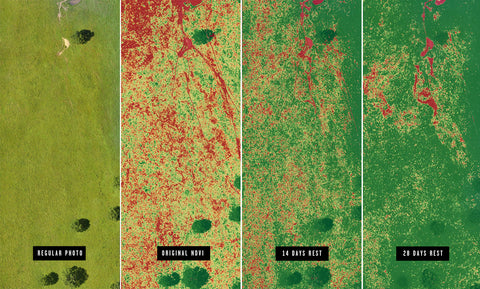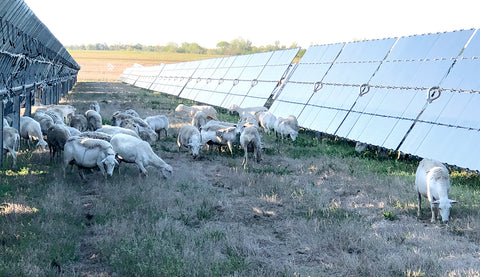 The rise of Industrial Agriculture was a result of the emergence of the mechanical mind driven by a fossil-fuel powered, energy intensive agriculture system that is completely dependent on mechanical and chemical interventions. Through advancements in technology we surmised that we no longer needed to “work” with nature because we could now “tame” nature and mold it too our specifications. This approach has led to our current disaster in agriculture where we are now using more resources than the Earth can regenerate, 40% of biology has been altered or wiped out, and we are losing a species every 20 minutes which is 6 times higher than the normal extinction rate. The age of machines has contributed to our ability to alter ecosystems quickly and on a huge scale. As Wes Jackson states in his book “New Roots for Agriculture”, “So destructive has the agricultural revolution been that, geologically speaking, it surely stands as the most significant and explosive event to appear on the face of the earth, changing the earth even faster than did the origin of life.” Our only hope for long term survival is to reverse these trends with regenerative agriculture. We must switch our reliance on large disruptive mechanical processes and chemical applications, and utilize methods that mimic nature, not work against it. There is no doubt that mother nature can make these decisions better than us but to get back to the proper balance of ruminants, browsers, and predators you need to go back in history 10,000 years before man began disrupting these natural behaviors. Obviously, we are not going back in time so we must “mimic” nature as best we can through regenerative methods, and this requires a massive undertaking in data collection devices, A.I. and other technology. One must understand that the mechanical mind follows a ‘reductionist” approach to solving complicated problems, meaning when the “machine” breaks you reduce it down to an individual part and repair it; however, one must also understand that while machines are complicated Nature is a complex system that does not respond well with a reductionist approach. Consequently, while advancements in technology got us in this mess if applied properly they can help get us out. To employ regenerative methods worldwide will be a massive effort based on our ability to manage these complex ecosystems much better. This will require massive amounts of continuous data to help make better decisions. A few such data collection devices that may be critical are satellite data, drones and remote sensing.
The rise of Industrial Agriculture was a result of the emergence of the mechanical mind driven by a fossil-fuel powered, energy intensive agriculture system that is completely dependent on mechanical and chemical interventions. Through advancements in technology we surmised that we no longer needed to “work” with nature because we could now “tame” nature and mold it too our specifications. This approach has led to our current disaster in agriculture where we are now using more resources than the Earth can regenerate, 40% of biology has been altered or wiped out, and we are losing a species every 20 minutes which is 6 times higher than the normal extinction rate. The age of machines has contributed to our ability to alter ecosystems quickly and on a huge scale. As Wes Jackson states in his book “New Roots for Agriculture”, “So destructive has the agricultural revolution been that, geologically speaking, it surely stands as the most significant and explosive event to appear on the face of the earth, changing the earth even faster than did the origin of life.” Our only hope for long term survival is to reverse these trends with regenerative agriculture. We must switch our reliance on large disruptive mechanical processes and chemical applications, and utilize methods that mimic nature, not work against it. There is no doubt that mother nature can make these decisions better than us but to get back to the proper balance of ruminants, browsers, and predators you need to go back in history 10,000 years before man began disrupting these natural behaviors. Obviously, we are not going back in time so we must “mimic” nature as best we can through regenerative methods, and this requires a massive undertaking in data collection devices, A.I. and other technology. One must understand that the mechanical mind follows a ‘reductionist” approach to solving complicated problems, meaning when the “machine” breaks you reduce it down to an individual part and repair it; however, one must also understand that while machines are complicated Nature is a complex system that does not respond well with a reductionist approach. Consequently, while advancements in technology got us in this mess if applied properly they can help get us out. To employ regenerative methods worldwide will be a massive effort based on our ability to manage these complex ecosystems much better. This will require massive amounts of continuous data to help make better decisions. A few such data collection devices that may be critical are satellite data, drones and remote sensing.
For example, to analyze and differentiate healthy vegetation from stressed vegetation, a widely used indicator known as the Normalized Difference Vegetation Index (NDVI) is applied to each image pixel. These images can be gathered by drone or satellite data pretty much 24/7. The logic behind this is that healthy, growing, green vegetation will reflect or scatter near-IR light back into the atmosphere; however, less healthy plants will reflect less near-IR light back into the atmosphere. This is captured in the NDVI image as a “red” color showing less reflection and a “green” color showing good reflection.
An actual value is given based on this equation:
NDVI = (NIR - RED) / (NIR + RED)
Those value are calculated for each pixel on the map with an index range from -1 to 1. Values that are less than 0.33 indicate unhealthy plant material and those values greater than 0.33 indicate healthy plant material on a sliding scale indicated by color.

Figure 1.

In the photographs above you can see the differences over time. The June 2nd photos are shown after animals have been grazed for approximately 30 days, the subsequent photos show it after resting. On the regular camera photographs there is some noticeable differences between June 2 and June 21 but hard to distinguish any noticeable changes after that. However, when you look at the NDVI images everything becomes quite clear, after 21 days of rest that pasture is ready to be impacted by animals again. This is critical data for a regenerative ranching method allowing land manager to make good decisions based on real data. Without this data we are simply guessing unless we put boots on the ground each time; however, when regenerative is scaled up to millions of acres then boots on the ground may not be feasible. Once again we have a new chance in the age of machines but this time let’s use it more wisely.




Comments (0)
There are no comments for this article. Be the first one to leave a message!